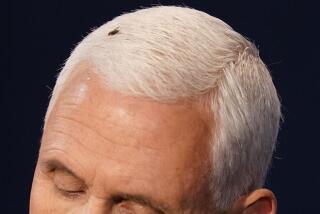Hail to the former right-hand men
- Share via
“I have Millard Fillmore’s hat,” Dan Johns says with pride.
Johns is executive director of the United States Vice Presidential Museum, a treasure trove of memorabilia of some of America’s most forgettable political figures. It is housed at the Dan Quayle Center and Museum in Huntington, Ind., Quayle’s hometown. Quayle, of course, was vice president under President George H.W. Bush.
Johns has picked up some Dick Cheney artifacts and says he’ll keep an eye out for John Edwards stuff, though perhaps the only politicians more obscure than vice presidents are vice presidential candidates who don’t win. And though the center houses the Quayle papers, the museum is mainly nonpolitical.
“We kind of keep our hands off current politics,” Johns says. “We wait till they’re old news and then take a historical look at them.”
He watched the televised announcement of Sen. John F. Kerry’s selection of Sen. John Edwards as a running mate on the Democratic ticket.
“He’s young and enthusiastic,” Johns says. “That kind of butts with the tradition of the old vice presidents.... He’s more in the mold of the modern vice president, which is a younger, more active politician. The more recent vice presidents have taken an increasingly more active role in the administration.”
The museum highlights Indiana candidates.
“We have a number of Hoosiers [who] ran for vice president and did not get elected,” Johns says. Five were elected -- second only to New York with 11, including Aaron Burr, the only vice president known to have killed a man while in office. That was Alexander Hamilton, whom Burr shot in a duel on July 11, 1804.
Fillmore’s top hat came to the museum after it turned up on EBay and a museum director bought it for $300. It was authenticated by Fillmore’s great-great-great-grandson.
Fillmore “wore this hat as he took the oath of office going from vice president to president after Zachary Taylor died,” Johns says. Fillmore was the last Whig president, and people tend to remember vice presidents who became presidents.
The museum has something from every vice president. There were 46, compared with 43 presidents, for a number of reasons. President Franklin D. Roosevelt, for example, had three.
“The oldest piece I have is an original newspaper from July 1789,” Jones says, “and it details Vice President John Adams breaking the first tie in the Senate.”
That’s one of the two official duties required of a veep by the Constitution. The other is to take over if a president dies or is removed from office.
“Fourteen became president,” he says. “Eight took over the office after the previous president died. One took over upon the resignation of the president, and then five were elected in their own right.”
One vice president, William King, was sworn into office in Havana, where he was being treated for tuberculosis. He served 45 days in office.
“Not a whole lot of people can name him off the top of their head,” Johns says. “He was Franklin Pierce’s vice president. He took the oath of office and then got back on a boat, docked at Mobile [Ala.], went back to his plantation home and died the next day.”
Many names draw a blank stare, Johns says, like George Mifflin Dallas. He was James Polk’s vice president, and he shepherded the annexation of Texas through the Senate.
“They named a little-bitty town in Texas in his honor.”
More to Read
Sign up for Essential California
The most important California stories and recommendations in your inbox every morning.
You may occasionally receive promotional content from the Los Angeles Times.













